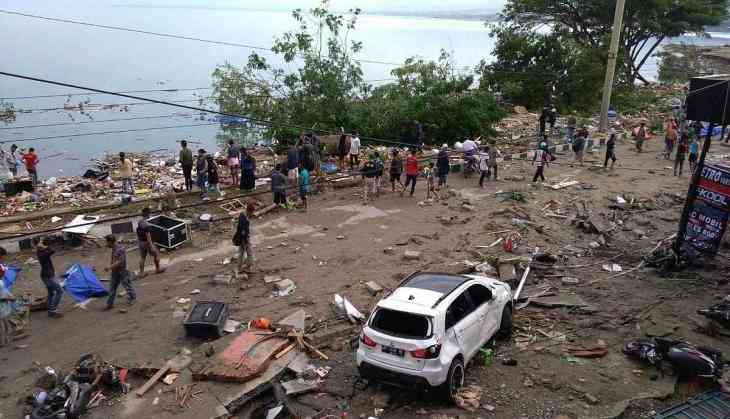
When the violent shaking from a massive magnitude 7.5 earthquake finally stopped, Selvi Susanti stood up and realized something strange was happening. First, she saw the ground suddenly begin to sink.
Then the pavement split beneath her feet like a broken dinner plate and started to rise. Terrified, she clung to a small sliver of asphalt and surfed a river of fast-moving mud as it swallowed entire neighborhoods, carrying her higher than coconut trees for a quarter of a mile.
"What I saw oh my God! Houses were tumbling. They started to roll like waves. It's like a tsunami, but the difference was they were waves of soil," said Susanti, 38, weeping at the memory of seeing so many people simply disappear into the earth as they screamed for help. "It felt like I was in a boat, moving around. But the difference is
I was not in water, but in the mud." Many, like Susanti in the devastated village of Petobo, had no idea they were in an area already identified by the government as a high-risk zone for the devastating geological phenomenon that causes soft ground to liquefy during earthquakes.
But Indonesian scientist Gegar Prasetya wasn't surprised by any of the events that occurred at dusk on Sept. 28, killing nearly 2,000 people and leaving possibly thousands more missing. He had warned people for years that the area around Sulawesi island's Palu Bay had been struck before and was due for another potential combination of factors to create a perfect storm capable of unleashing earthquakes, landslides, tsunami waves and soil liquefaction.
"I knew right away," said Prasetya, co-founder of the Tsunami Research Center Indonesia, who had met with government officials and residents in the area to try to raise awareness about the threat. "I posted in our group, and I said, 'It's happened.'"
Disaster-prone Indonesia, part of the Pacific Basin's "Ring of Fire," is an archipelago of about 17,000 islands sitting atop numerous fault lines that have produced some of the largest and most deadly earthquakes, tsunamis and volcanic eruptions in recorded history.
Other scientists around the world wondered how this type of earthquake on a strike-slip fault, which typically does not produce dangerous tsunamis could generate waves that surged as high as 6 meters (20 feet). Again, Prasetya knew.
He had published a paper nearly two decades ago highlighting six other tsunamis recorded in the Makassar Strait in the past century, predicting that a repeat event could be expected roughly every 25 years. The last one occurred in a region north of the city in 1996. Before that, Palu Bay was hit in 1968 by a very similar magnitude 7.4 quake that generated waves 10 meters (33 feet) high.
"This one complete village went to the sea," he said of the 1968 event. "You can still see the trees from the top of the water." Some experts theorize that the Sept. 28 quake, by itself, didn't generate a big wave despite being shallow and near the coast.
They're convinced it was instead the area's soft soil that served as the real catalyst for disaster. The temblor's long, violent shaking likely triggered one or more underwater landslides due to unstable sediment deposited on the seafloor by rivers. This disruptive movement may have created the large wall of water that raced across the open ocean until being squeezed into the long, narrow bay that surrounds Palu, forcing the wave to grow higher.
"Imagine what happens if you drop a brick in a flat pond ripples spread in all directions," said Robert Hall, a geologist at Royal Holloway University of London, who has studied the area. "Now drop the same size object in a bathtub. The waves can reflect off the sides, can amplify, and may get larger in the direction of the length of the bath." But it wasn't just weak sediment in the ocean that gave way. Wet, sandy soil also separated and came alive through liquefaction in some areas due to the earthquake's radical vibrations.
The ground simply lost its strength and turned to mush beneath people's feet, creating mud that acted like quicksand. People, houses, cars and streets were swallowed and covered by a thick carpet of what just seconds earlier had been solid earth. Fast-moving landslides also were launched above ground, possibly causing even more localized tsunami waves.
"We wouldn't necessarily expect to get all the worst possible factors occurring together," said Willem De Lange, a scientist from the University of Waikato in New Zealand who co-authored research on the area with Prasetya in 2001. "Unfortunately this does happen." Many questions remain about exactly what happened in this complex disaster. Prasetya will begin field work with the Indonesian navy this week to try to better understand what occurred under water, and a team of international experts are expected to arrive soon to survey the area.
Palu's population has exploded in many high-risk areas since the 1968 event, which killed 200 people and also turned soil to mud in places, leaving many newcomers vulnerable with no local history.
However, the central government did produce a map in 2012 identifying large swaths of Palu, a city of 380,000 people, where liquefaction could occur. The area of Petobo, for instance, was classified as having high-risk potential. The report also recommended that housing and industrial areas should best be built in areas with low liquefaction risk. It suggested mitigation efforts, including building structures with deep foundations anchored into firmer layers of earth.
Good urban planning is ultimately the key to saving lives, said Sri Hidayati, head of earthquake mitigation at the Energy Ministry's Geology Agency, which produced the report that was shared with the provincial and district governments in Sulawesi. She said it's her agency's responsibility to provide the mapping, but it's up to local authorities to "use it or not." Calls Monday to Palu's vice mayor and the mayor's aid went unanswered.
-PTI


